The Masked Angelfish (Genicanthus personatus) known to tropical fish keeping enthusiasts as the Masked Angel, Masked Angel Fish, or Personatus Angelfish is endemic to Hawaii, and relatively common at Kure, Midway, Pearl and Hermes Reefs in the Midway Islands northeast of Hawaii.
The Masked Angelfish is a beautiful, peaceful, and rarely seen species that is found in cooler waters at depths from around 100 feet to almost 570 feet along their 1500 mile Pacific Ocean island chain range. The first female specimen was discovered and described in 1972 by John Randall near Waikiki, and later that year, a male specimen was also described in that same area.
Because of their preference for cooler water, Masked Angelfish are reliably seen at depths over 300 feet in Kauai, and in progressively shallower depths around the Northwestern Hawaiian Islands and the highly protected waters of Papahānaumokuākea National Marine Sanctuary where collection of aquarium fish species is prohibited.
At the extreme end of their range around Pearle and Hermes reefs where the waters are cooler; they are often spotted in less than 100 feet of water.
Where legal collection of tropical aquarium fish is allowed; Genicanthus personatus is only found in extremely deep water close to the depth limits of SCUBA diving.
Masked Angelfish are protogynous hermaphrodites that begin their lives as females and eventually turn into males. They are also sexually dichromatic and are one of the few angelfish to exhibit dramatic sexual dimorphism as they grow and change sex.
Juvenile Masked Angelfish are a brilliant, stunning pearly white color with a small black patch over the face, eyes, and mouth.
As they grow into adolescents, the black facial mask becomes punctuated with blueish white lips, and the tail becomes mostly black.
Adult female Masked Angelfish (below) retain their all white body color and mostly black tail, but the black mask on their face becomes smaller and they develop yellow pelvic fins.
As they grow, the amount of black on the face gradually shrinks to encircle the eyes, with some black under the lips, and lower edging of the gill covers.
When females grow to about seven inches in length, they begin to change into males.
Adult male Genicanthus personatus retain their pearly white body color and black front portion of the caudal fin; but the anterior portion of the head from the snout to just behind the eye, the pectoral fins, the pelvic fins, and the broad band edging of their dorsal and anal fins become a bright yellow to yellow orange, or orange color.
Adult males also develop long, swallow like tails.
The Masked Angelfish is best housed in a mature deep water reef aquarium of at least 200 gallon capacity with a sand or crushed coral substrate and a substantial amount of live rock arranged into caves, crevices, and overhangs for them to hide among. They are considered to be completely reef safe and can be housed in either a reef or fish only system.
If you ever happen to acquire a Masked Angelfish, aquarium temperature and proper acclimation procedures are a primary concern.
Like other deep water angelfish, this species requires pristine water quality and water temperatures between 66 and 77 degrees F. This requires regular water changes, an excellent reef filtration system augmented with a chiller, and powerheads to maintain water parameters.
Although the Masked Angelfish has been bred in an aquarium environment, it has happened only once in captivity by Karen Brittain over 10 years ago. The recommended method to obtain a breeding group (or harem) is to start out with 2 or more females and allow the dominant fish to change into a male over the course of a few months. Raising the larvae to adulthood is the most difficult part of successfully breeding this species.
Masked Angelfish are planktivores that require a diverse diet with frequent feedings to successfully keep them in good condition in an aquarium environment. They do well on prepared and frozen foods like krill, raw table shrimp, squid, Mysis shrimp, Zooplankton, mussels, clams, sponge fortified Angelfish formulas, and occasionally supplements of a herbivore diet that contains marine algae. They do best when fed small portions multiple times a day.
For the past ten years, only one or two Masked Angelfish (Genicanthus personatus) have been collected alive every year, and some years, none were available to tropical fish keeping enthusiasts at any price. Understandably, the masked angelfish is one of the most expensive aquarium fish in the world, with a single specimen sometimes exceeding $10,000.
In 2009 a pair was sold to a rare fish collector in Hong Kong for $30,000.00.
At least one dedicated web site we found now sells them online for $16,000.00 on a pre-order basis, but for most tropical fish keeping enthusiasts, we can only dream about acquiring one.
Minimum Tank Size: 200 gallons
Aquarium Type: Deepwater Reef
Care Level: Advanced
Temperament: Peaceful
Aquarium Hardiness: Hardy when acclimated
Water Conditions: 66.2 °F – 77 °F, 8 to 12 dKH , pH 8.0 – 8.5, sg 1.020-1.026
Max. Size: M 8.3″
Color Form: White, Black, Orange
Diet: Omnivore (Planktivore)
Compatibility: Deepwater Reef, peaceful tankmates
Origin: Hawaii, Midway Islands
Family: Pomacanthidae
Lifespan: Unknown
Aquarist Experience Level: Professional

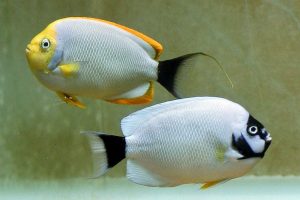
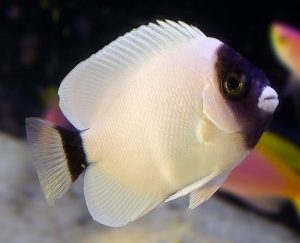
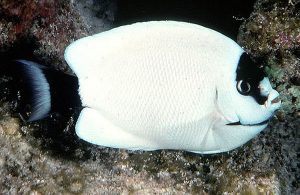
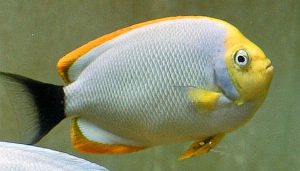
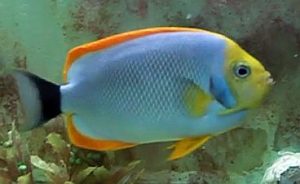

Do you do export? Can we get the female masked angelfish from you?
We do not export fish. Check out this link for marine fish, inverts, corals, etc.
https://www.anrdoezrs.net/sj118hz74z6MVOPVVWVMONSPTVVU?sid=mskdangl